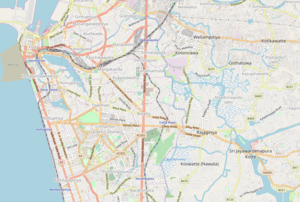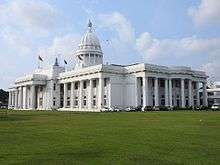Town Hall, Colombo
The Town Hall of Colombo is the headquarters of the Colombo Municipal Council and the office of the Mayor of Colombo. Built in front of the Viharamahadevi Park, Colombo, Sri Lanka, it is the meeting place for the elected municipal council.
| Colombo Town Hall | |
|---|---|
 Location in greater Colombo | |
| General information | |
| Architectural style | Neoclassical |
| Town or city | Colombo |
| Country | Sri Lanka |
| Coordinates | 6°54′57.06″N 79°51′49.63″E |
| Construction started | 24 May 1924 |
| Completed | 9 August 1928 |
| Client | Colombo Municipal Council |
| Height | 51.3 m (168 ft) |
| Design and construction | |
| Architect | S. J. Edwards |
| Architecture firm | Ralph Booty & Co Ltd |
| Main contractor | A. A. Gammon and Co |
In 1921 renowned Scottish town planner, Professor Patrick Geddes, recommended that the Council should construct a large central and dignified municipal building to house the council, a public reception hall, the mayor's office and a public library. The need for the Colombo Public Library was addressed by a philanthropic donation of a building by Dr. W. Arthur Silva in 1925.[1] This building, Sirinivasa, is now the official residence of the mayor.
In 1922 the Colombo Municipal Council held an international architectural design competition and in November that year of the 32 plans submitted, the winning design was drawn by S. J. Edwards, of the architectural firm Ralph Booty & Co.[2] In awarding the prize the Government Architect of the Ceylon Public Works Department, Austin Woodeson, wrote:
"The buildings are admirably laid out on the site; the outbuildings are well secluded, but very accessible. The main building stands out prominently and would command pleasing views from all angles. The connecting roads are well laid out. The details and plans are excellently drawn, and illustrate in an artistic manner a most striking and effective design." "The connecting roads are well laid out. On the ground floor the corridors are straightforward, direct and well lighted. The general disposition of the departments and rooms is excellent and most convenient for access, circulation and inter-communicable both for the public and staff. On the upper floors, the offices are admirably arranged. The Council chamber is a magnificent apartment with ample accommodation for the public provided in an elevated gallery." "This provision gains many favourable points for this design. The elevations are very dignified and refined. The perspective view shows a very impressive group of buildings crowned by a dome and tower of fine proportions. The details and plans are excellently drawn, and illustrate in an artistic manner a most striking and effective design."[3]
The foundation stone for the town hall was laid on 24 May 1924, by the Mayor of Colombo, Thomas Reid, CCS.[4] The construction of the building was undertaken by A. A. Gammon & Co[5] and four years later on 9 August 1928 it was formally opened by the Governor Sir Herbert Stanley KCMG.[6] The cost of the new town hall was met largely by revenue generated by the Council, without taking out any loans from the central government and as a result, for years Municipal finances were depleted.
Architectural design


Edwards' design draws heavily from L'Enfant's neoclassical style Capitol Building in Washington, D. C.
The Council chamber is located in the centre of the block on the first floor surmounted by a dome. On either side and on the longitudinal axis is an open courtyard surrounded on each floor by the different departments of Council. The main entrance and staircase hall is situated at the centre of the front façade, facing directly onto Viharamahadevi Park, with the two staff entrances being at the two remote corners of the façade in the rear. There are six corinthian columns in the main porch, six on either side to the front and ten columns on either side of the building. The columns are each 11.6 m (38 ft) in height. The building is 108 m (354 ft) in length and 51.3 m (168 ft) in width and the total height of the building equals its width.[7]
Although many alterations have been made to the original design, the building still possesses a few characteristics that have not been touched by modern renovations. The council chamber and its furniture, including the original lamps and lamp bases are still intact. All the doors and windows of the building are original, as well as the ornamental lamps on the staircase leading to the second floor from the lobby.[8]
References
- "Centenary commemoration of a philanthropist". The Nation. 21 December 2008. Retrieved 5 January 2015.
- "Colombo's Public Offices". The Straits Times. 6 March 1923. p. 10.
- Gaveshaka, Sathya. "The imposing 'white house' in the City". The SundayTimes. Retrieved 18 August 2016.
- "Colombo's New Town Hall". The Singapore Free Press and Mercantile Advertiser. 2 June 1924. p. 6. Retrieved 17 August 2016.
- Gaveshaka, Sathya (20 May 2007). "The imposing Town Hall". The SundayTimes. Retrieved 18 August 2016.
- "Colombo's New Town Hall". The Singapore Free Press and Mercantile Advertiser. 25 August 1928. p. 13. Retrieved 17 August 2016.
- "Treasures from colonial days". Daily FT. 22 September 2012. Retrieved 18 August 2016.
- Prematunge, Sajitha (22 February 2009). "Under the dome, Architecture of Town Hall". Sunday Observer. Retrieved 18 August 2016.
External links
| Wikimedia Commons has media related to Colombo Town Hall. |
- Hulugalle, H. A. J. (1965). Centenary Volume of the Colombo Municipal Council: 1865-1965. Colombo: Colombo Municipal Council.